|
 |
| Adult with regenerating tail, Kern County |
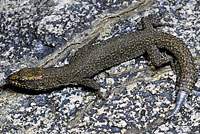 |
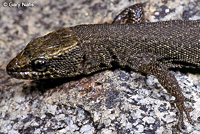 |
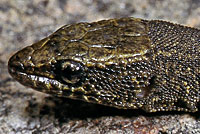 |
| Adult with regenerating tail, Kern County |
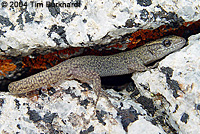 |
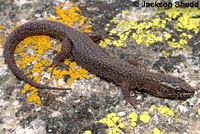 |
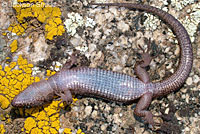 |
| Adult, Kern County © Tim Burkhardt |
Adult, Kern County © Jackson Shedd |
| |
 |
|
| |
Night Lizards, genus Xantusia, have small granular scales on soft skin.
Xantusia henshawi is shown here. |
|
| |
|
|
| Habitat |
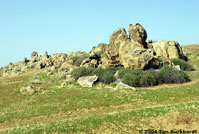 |
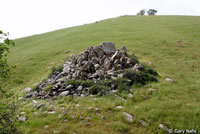 |
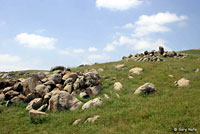 |
Habitat, Kern County
© Tim Burkhardt
|
Habitat, Kern County |
Habitat, Kern County |
| |
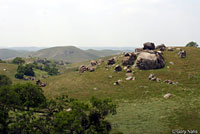 |
|
| |
Habitat, Kern County |
|
|
|
|
| Description |
| |
| Size |
1.5 - 2.75 inches long from snout to vent (3.8 - 7 cm). (Stebbins 2003)
|
| Appearance |
A small thin lizard with soft skin with fine granular scales on most of the body, a head covered with large plates, lidless eyes with vertical pupils, a gular fold, and a detachable tail.
The head and body tend to be flattened, an adaptation to this lizard's rock-crevice habitat.
Dorsal scales in 40 -44 lengthwise rows at mid-body.
|
| Color and Pattern |
Color is olive, grayish, or brown with light brown or black spots which tend to be interconnected, forming a dark net-like pattern.
A broad and conspicuous stripe extends from the eye to the shoulder.
The underside is whitish and made up of large square scales, usually in 12 rows. |
| Male / Female Differences |
Males have enlarged femoral pores.
|
| Life History and Behavior |
Activity |
Little is known about this lizard.
Presumably it is similar to other California Xantusiids, being diurnal (contrary to the common name) and crepuscular.
It is certainly secretive - spending most of its life undercover, and a specialized rock-crevice dweller, living under flakes of granite on rocky outcrops and in rock crevices.
It is not typically active on the surface away from cover.
|
| Defense |
The tail can break off easily, but it will grow back.
The detached tail wriggles on the ground which can distract a predator from the body of the lizard allowing it time to escape.
More information about tail loss and regeneration. |
| Diet and Feeding |
| Little is known about the diet of this lizard. Presumably it is similar to other related California Xantusiids, which eat small invertebrates such as ants, termites, beetles, caterpillars, crickets, and spiders. |
| Reproduction |
Little is known about the reproduction of this species.
Related California Xantusiidae breed in late spring and the young are born live, 1-3 per brood, from August to October.
|
| Habitat |
Inhabits rocky outcrops around Granite Station in open grassland with scattered oak woodland and low shrubs.
|
| Geographical Range |
Endemic to California.
Found only in the southwestern foothills of the Sierra Nevada Mountains along the western edge of the Greenhorn mountains around Granite Station, in Kern Co.
|
| Notes on Taxonomy |
Described by Bezy in 1967.
---------------------------------------------------------------------------------------------------------------------------------------------------------------------
Several subspecies of Xantusia vigilis were traditionally recognized, including two in California -
X. v. vigilis
X. v. sierrae (now X. sierrae)
---------------------------------------------------------------------------------------------------------------------------------------------------------------------
Using nuclear DNA studies, Leavitt et al, 2007, provide support for the recognition of new species within the X. vigilis complex, including X. wigginsi in California, but they continue to recognize the subspecies X. v. vigilis and X. v.sierrae. In addition, they identify several major clades, four of which occur in California - X. vigilis, X. wigginsi (now a full species), a Yucca Valley clade, and a San Jacinto clade.
---------------------------------------------------------------------------------------------------------------------------------------------------------------------
The 2008 Society for the Study of Amphibians and Reptiles Standard Names List uses X. sierrae based on Sinclair et. al (2004, Am. Nat. 164:396-141) with this note:
"Sinclair et al. (2004, Am. Nat. 164: 396–414) considered the treatment of Xantusia sierrae as a separate species from X. vigilis as tentative, because of nesting of mtDNA haplotypes of the former within those of the latter (see also Leavitt et al., 2007, Mol. Ecol. 16: 4455–4481 and Noonan et al. 2013, Mol. Phylogenet. Evol. 69: 109–122)."
---------------------------------------------------------------------------------------------------------------------------------------------------------------------
"The standard English name for this clade has been changed (by adding “Northern”), following Bezy (2019, Night Lizards, Eco Herpetological Publishing), to eliminate redundancy with the English name of the clade Xantusiidae."
(Nicholson, K. E. (ed.). 2025 SSAR Scientific and Standard English Names List)
---------------------------------------------------------------------------------------------------------------------------------------------------------------------
Alternate and Previous Names (Synonyms)
Xantusia vigilis sierrae - Sierra Night Lizard (Stebbins 1985, 2003)
|
| Conservation Issues (Conservation Status) |
| Due to its small range, the Sierra Night Lizard is very suceptible to any habitat alteration. This lizard needs exfoliated and fissured granite outcrops to survive. It takes thousands of years for this exfoliation and fissuring to occur, so this habitat will not be replaced for many centuries. When flakes and slabs are torn off rock outcrops by someone searching for this lizard or other reptiles, the habitat is irreparably damaged. Such rock destruction is illegal in California: "It is unlawful to use any method or means of collecting that involves breaking apart of rocks, granite flakes, logs or other shelters in or under which reptiles may be found." (2007 regulations 5.60.4.) However, this does not protect the lizard from other sources of rock destruction including human development of its habitat. |
|
|
Taxonomy |
| Family |
Xantusiidae |
Night Lizards |
Baird, 1858 |
| Genus |
Xantusia |
Night Lizards |
Baird, 1859 “1858” |
Species
|
sierrae |
Sierra Night Lizard |
Bezy, 1967 |
|
Original Description |
Xantusia vigilis - Baird, 1858 - Proc. Acad. Nat. Sci. Philadelphia, Vol. 10, p. 255
Xantusia vigilis sierrae - Bezy, 1967 - Journ. Arizona Acad. Sci., Vol. 4, p. 163
from Original Description Citations for the Reptiles and Amphibians of North America © Ellin Beltz
|
|
Meaning of the Scientific Name |
Xantusia - honors Xantus, John
sierrae - of the Sierra Nevada Mountains - type locality, Kern County, CA
from Scientific and Common Names of the Reptiles and Amphibians of North America - Explained © Ellin Beltz
|
|
Related or Similar California Lizards |
X. henshawi - Granite Night Lizard
X. gracilis - Sandstone Night Lizard
X. vigilis - Desert Night Lizard
X. r. reticulata - San Clemente Night Lizard
|
|
More Information and References |
California Department of Fish and Wildlife
Robert L. Bezy. Night Lizards: Field Memoirs and a Summary of the Xantusiidae. ECO Herpetological Publishing & Distribution. 2019.
Hansen, Robert W. and Shedd, Jackson D. California Amphibians and Reptiles. (Princeton Field Guides.) Princeton University Press, 2025.
Stebbins, Robert C., and McGinnis, Samuel M. Field Guide to Amphibians and Reptiles of California: Revised Edition (California Natural History Guides) University of California Press, 2012.
Stebbins, Robert C. California Amphibians and Reptiles. The University of California Press, 1972.
Flaxington, William C. Amphibians and Reptiles of California: Field Observations, Distribution, and Natural History. Fieldnotes Press, Anaheim, California, 2021.
Nicholson, K. E. (ed.). 2025. Scientific and Standard English Names of Amphibians and Reptiles of North America North of Mexico, with Comments Regarding Confidence in Our Understanding. Ninth Edition. Society for the Study of Amphibians and Reptiles. [SSAR] 87pp.
Samuel M. McGinnis and Robert C. Stebbins. Peterson Field Guide to Western Reptiles & Amphibians. 4th Edition. Houghton Mifflin Harcourt Publishing Company, 2018.
Stebbins, Robert C. A Field Guide to Western Reptiles and Amphibians. 3rd Edition. Houghton Mifflin Company, 2003.
Behler, John L., and F. Wayne King. The Audubon Society Field Guide to North American Reptiles and Amphibians. Alfred A. Knopf, 1992.
Robert Powell, Roger Conant, and Joseph T. Collins. Peterson Field Guide to Reptiles and Amphibians of Eastern and Central North America. Fourth Edition. Houghton Mifflin Harcourt, 2016.
Powell, Robert., Joseph T. Collins, and Errol D. Hooper Jr. A Key to Amphibians and Reptiles of the Continental United States and Canada. The University Press of Kansas, 1998.
Bartlett, R. D. & Patricia P. Bartlett. Guide and Reference to the Turtles and Lizards of Western North America (North of Mexico) and Hawaii. University Press of Florida, 2009.
Jones, Lawrence, Rob Lovich, editors. Lizards of the American Southwest: A Photographic Field Guide. Rio Nuevo Publishers, 2009.
Smith, Hobart M. Handbook of Lizards, Lizards of the United States and of Canada. Cornell University Press, 1946.
|
|
|
The following conservation status listings for this animal are taken from the April 2024 State of California Special Animals List and the April 2024 Federally Listed Endangered and Threatened Animals of California list (unless indicated otherwise below.) Both lists are produced by multiple agencies every year, and sometimes more than once per year, so the conservation status listing information found below might not be from the most recent lists. To make sure you are seeing the most recent listings, go to this California Department of Fish and Wildlife web page where you can search for and download both lists:
https://www.wildlife.ca.gov/Data/CNDDB/Plants-and-Animals.
A detailed explanation of the meaning of the status listing symbols can be found at the beginning of the two lists. For quick reference, I have included them on my Special Status Information page.
If no status is listed here, the animal is not included on either list. This most likely indicates that there are no serious conservation concerns for the animal. To find out more about an animal's status you can also go to the NatureServe and IUCN websites to check their rankings.
Check the current California Department of Fish and Wildlife sport fishing regulations to find out if this animal can be legally pursued and handled or collected with possession of a current fishing license. You can also look at the summary of the sport fishing regulations as they apply only to reptiles and amphibians that has been made for this website.
The California Special Animals List uses the name Xantusia vigilis sierrae - Sierra Night Lizard with this note: "Formerly Xantusia sierrae; scientific name changed to reflect currently accepted subspecies concept."
|
| Organization |
Status Listing |
Notes |
| NatureServe Global Ranking |
G5T1 |
Secure—Common; widespread and abundant.
[This ranking apparently refers to the full species that this taxa formerly belonged to, Xantusia vigilis, and indicates that the status of the species is secure, not the subspecies.] |
| NatureServe State Ranking |
S1 |
Critically imperiled in the state because of extreme rarity (often 5 or fewer populations) or because of factor(s) such as very steep declines making it especially vulnerable to extirpation from the state.
|
| U.S. Endangered Species Act (ESA) |
None |
|
| California Endangered Species Act (CESA) |
None |
|
| California Department of Fish and Wildlife |
SSC |
Species of Special Concern |
| Bureau of Land Management |
None |
|
| USDA Forest Service |
S |
Sensitive |
| IUCN |
None |
|
|
|
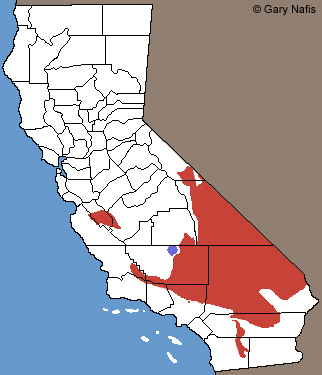 Dark Blue: Range of this species in California
Dark Blue: Range of this species in California












